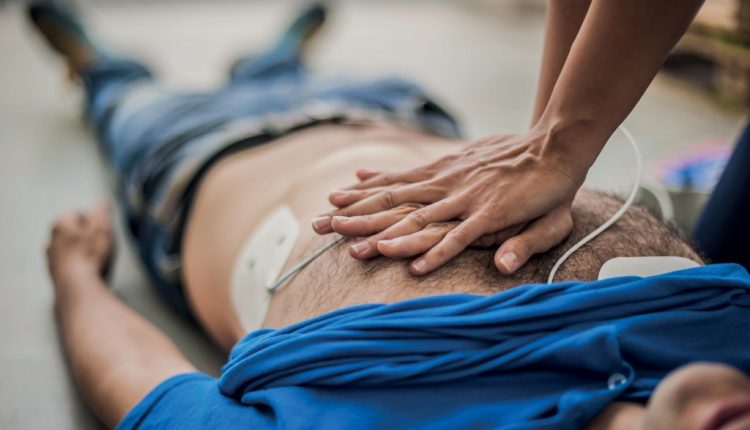
Survive an OHCA - The American Heart Association: hands-only CPR increases survival rate
Survive an OHCA – The American Heart Association revealed that hands-only CPR increases survival rate.
A Swedish review of out-of-hospital cardiac arrest (OHCA) data shows rates of bystander CPR nearly doubled; compression-only (or Hands-Only CPR) increased six-fold over an 18 year period; and the chance of survival was doubled for any form of CPR compared with no CPR, according to new research in the American Heart Association’s journal Circulation.
Because of the emergence of compression-only CPR as an alternative to standard CPR — chest compressions and mouth-to-mouth rescue breaths, researchers analyzed the impact of the simpler Hands-Only CPR technique and the association between the type of CPR performed and patient survival for 30 days.
Hands-only CPR: the impact
“We found a significantly higher CPR rate for each year, which was associated with higher rates of compression-only CPR,” said Gabriel Riva, M.D., a Ph.D. student at the Karolinska Institutet in Stockholm, Sweden, and the study’s first author. “Bystanders have an important role in out-of-hospital cardiac arrest. Their actions can be lifesaving.”
“CPR in its simplest form is just chest compressions. Doing only chest compressions doubles the chance of survival, compared to doing nothing,” he said.
Riva noted that current guidelines in Sweden promote CPR with rescue breathing by those trained and able, but it is unclear if that is better than Hands Only CPR by bystanders. An ongoing randomized trial in Sweden is now trying to answer this question.
“This is important since CPR performed by bystanders before emergency services arrival is one of the most important factors for surviving an out-of-hospital cardiac arrest. Thus, increasing CPR rates by simplifying the CPR algorithm for bystanders can increase overall survival,” he said.
Cardiac arrests outside of the hospital: a great problem for the United States
More than 325,000 cardiac arrests occur outside of the hospital each year in the United States, according to American Heart Association statistics. Cardiac arrest is the abrupt loss of heart function, can come on suddenly and often is fatal if appropriate steps aren’t taken immediately.
This national study of data from the Swedish register focused on bystander witnessed OHCA involving 30,445 patients. Overall, 40 percent received no bystander CPR, 39 percent received standard CPR and 20 percent received compressions only.
Researchers examined three time periods — 2000 to 2005, 2006 to 2010 and 2011 to 2017 — when compression-only CPR was being gradually adopted within Sweden’s CPR guidelines.
Researchers found patients who received:
- Bystander CPR rates rose from 40.8 percent in 2000-2005 to 58.8 percent in 2006-2010 and then to 68.2 percent in 2011-2017.
- Standard CPR rates were 35.4 percent in the first period, increased to 44.8 percent in the second period and changed to 38.1 percent in the third period.
- Hands-Only CPR increased from 5.4 percent in the first period, increased to 14 percent in the second period and 30.1 percent in the third period.
Patients receiving standard and Hands-Only CPR were two times more likely to survive 30 days, compared with patients who received no CPR for all time periods.
About the study: limitations to be aware of
Limitations include that the study is based on observational data collected over time, which presents a risk of miscalculation of rescue breaths and chest compressions at the time of emergency medical services arrival and missing data of other variables. Because the study was conducted in Sweden, results may not be generalizable to other countries.
The findings support compression-only CPR as an option in CPR guidelines because it is associated with increased CPR rates and overall survival in OHCA and is in line with previous findings reported from the United States and Japan.
OHCA and Hands-only CPR: what are the conclusions of the study
The American Heart Association says immediate CPR can double or triple chances of survival after cardiac arrest. Keeping the blood flow active — even partially — extends the opportunity for a successful resuscitation once trained medical staff arrive on site.
“I’ve noticed how more and more receptive the public continues to become when learning the benefits and potential of CPR, especially the Hands-Only CPR method,” said Manny Medina, a paramedic and AHA volunteer. “Over the last ten years, I continue to hear stories of people of all ages learning CPR and having to put those skills into action to save someone they love. It is so easy to learn and continues to be proven very effective when utilized outside of the hospital.”
Researchers said more research is needed to answer the question of whether standard CPR with compression and rescue breaths provides a more significant benefit, compared with compression-only CPR in cases in which the bystanders who give aid have had previous CPR training.
READ ALSO
Out-Of-Hospital Cardiac Arrests and COVID, The Lancet issued a study on OHCA increase
OHCA as Third Leading Cause of Health-loss Disease in US
Drones in emergency care, AED for suspected out-of-hospital cardiac arrest (OHCA) in Sweden
Does air pollution impact on OHCA risk? A study by University of Sydney



